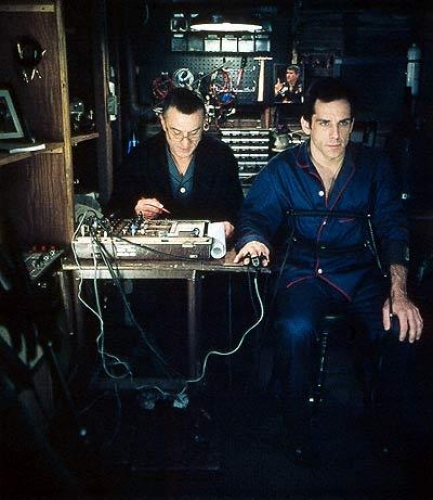Ben Stiller may be pulling in 15 million a movie these days. But there was a time when he was struggling to make a name for himself. In fact, Stiller had been in a string of commercially unsuccessful movies and TV shows, only recently making a name for himself in 1998 with “There’s Something About Marry.” “Meet the Parents,” then, established him as a legitimate comedic force. Now what most people don’t know, is that “Meet The Parents” is actually a remake of a 70+ minute indie film from 1992 that nobody saw. It starred, of all people, Emo Phillips, that bizarre guy with the extreme bowl cut who was famous for like 56 minutes. The film played the festival circuit and actually earned a few fans from critics. Universal reluctantly optioned the remake rights and only after Jim Carrey and Steven Spielberg showed interest (isn’t it Spielberg’s job to show interest in everything at least once?) did the studio really start to push it, eventually casting, of course, Ben Stiller and Robert DeNiro. Another little known factoid is that DeNiro came up with the famous lie detector test scene all on his own.
1) Set up the stakes for your main character before the journey begins – One of the reasons Meet The Parents works so well is because it establishes the stakes for Greg (Ben Stiller) right away. We see Greg trying out his proposal on one of his patients. We then see him go through an elaborate failed proposal to his girlfriend, Pam. Through these scenes, we see that getting this girl’s hand means everything to him (high stakes!). If we don’t know how much achieving the goal means to our character, we won’t care if he achieves it or not. So establish those stakes!
2) Once you establish the goal, you can introduce the main obstacle – The goal here is Greg trying to win Pam’s hand in marriage. Now obviously, if your character succeeds in achieving his goal, your movie is over. So before they can achieve it, you must hurry and introduce the main obstacle. The obstacle in this case is Pam’s father, Jack. Pam makes it clear that she can’t marry anyone her father doesn’t approve of. Now that we have the main obstacle, something that will repeatedly prevent our character from achieving his goal, we have ourselves a movie.
3) Clever over Big – In the original script, the Greg proposal scene had him taking Pam to a baseball game and proposing to her via plane pulling a “Will You Marry Me” sign. Not only has the ball game thing been done before, but it was far too expensive to shoot. So they re-wrote the scene to happen outside of Pam’s work (she’s a kindergarten teacher). While Greg distracts Pam, her students hold letters that spell “Will You Marry Me?” behind them. Of course, all the letters are in the wrong order, so Greg must guide them into their spots with his eyes without Pam noticing. Before they can finish, Pam gets a call from her father that negates the proposal. The point here is, everybody always thinks of the big giant easy scene – even the professionals. Ignore the big. Try to do something clever instead. It always ends up better.
4) In comedies, keep having your characters fail – That’s all comedies are if you think about it. You keep setting these little goals up, then continue to have your character fail at them. Greg must make a great first impression on Jack when he and Pam arrive. He fails. Greg has to win over Jack at the big dinner scene. He fails. Greg has to win the volleyball game to prove his toughness in front of Jack. He fails. Greg has to find Jack’s cat that he lost. He fails. In comedies, just keep having goal after goal come up, and have your character fail again and again, until they finally come through in the end.
5) Design your other characters with your main character in mind – When you design your supporting characters, they shouldn’t be designed randomly, but rather as a way to affect or conflict with your protagonist. For example, Greg is a nurse. When he gets to Pam’s, Pam’s sister is celebrating her recent engagement to her longtime boyfriend, Bob. Now, what would you have Bob be? A race car driver maybe? A lawyer? A scientist? Sure, I mean any one of those could work. But the writers make him a DOCTOR, because they know it will make Greg (who’s a nurse) look even worse in the eyes of Jack.
6) Always look to go against type in comedies – Most comedy specs I read go with the obvious. So for the father our main character has to win over, they’d make him a military man with a giant dog. Not here. Jack is a botanist with a Persian cat. Go against type go against type go against type!
7) Torture your main character in a comedy whenever and wherever possible – It’s a comedy. So have fun torturing your main character. At the airport, the TSA forces Jack to check his bag, and of course they lose his bag. This leaves him without clothes, forcing him to have to wear Pam’s brother’s clothes. Now since it’s our job as writers to torture our protagonists, we can’t just give him normal clothes. Nope, the writers make Pam’s brother a younger hip-hop druggie type. Therefore Greg ends up having to wear these ridiculous oversized hip-hop clothes. We see it again later in the water volleyball game where Greg is forced to wear a tiny speedo. Torture your characters people!
8) Add twists to your comedies – Writers assume that since comedies are all about the laughs, they don’t need to add any twists or turns. The assumption is that you save those for the thrillers and the sci-fi specs. The thing is, a comedy is still a story, and every story needs a few surprises along the way to keep the audience guessing. In the original draft for “Meet The Parents,” Jack’s CIA background is revealed right away. The writers realized that doing so was kind of boring, and therefore pushed the reveal back and made it a surprise, with Jack initially pretending to be a botanist.
9) Combine scenes for Christ’s sake! – Writers always act shocked or upset or confused when I tell them they need to combine two average scenes into one super scene in order to speed up their story. Combining scenes ia great option to deleting them altogether because you get to keep all the stuff you like instead of losing it altogether. So in the original “Meet The Parents” draft, we had the big dinner scene (“I have nipples Greg. Can you milk me?”) and then a game of scrabble, where Greg accidentally pops the cork that destroys the bottle holding Jack’s mother’s ashes. The scrabble scene was extremely weak and redundant, so they just combined it into the dinner scene. Which scenes can you combine in your script?
10) When limited to one location, the easiest way to change up the plot is to bring in new characters – When you’re writing a thriller or an adventure script or, really, any script where your character is out in the world doing shit, it’s easy to spice things up. You just move to a new location with a new set of goals, stakes, and urgency. But when you’re in a single location, you obviously can’t do that. Therefore, you need to find other ways to keep the script interesting. The Greg, Pam, Jack, and Dina stuff is great. But if we’re ONLY with those four inside this house the entire script, we’re going to get bored. The easiest way to spice things up then, is to bring in new characters. They become the change. Here, it’s Debbie (Pam’s sis) and Bob (her fiancé) who pop in and start adding more pressure to the situation (with Bob being Jack’s ideal son-in-law). Immediately we feel a new energy in the script, and the story is reignited.
 These are 10 tips from the movie “Meet The Parents.” To get 500 more tips from movies as varied as “Aliens,” “Pulp Fiction,” and “The Hangover,” check out my book, Scriptshadow Secrets, on Amazon!
These are 10 tips from the movie “Meet The Parents.” To get 500 more tips from movies as varied as “Aliens,” “Pulp Fiction,” and “The Hangover,” check out my book, Scriptshadow Secrets, on Amazon!


